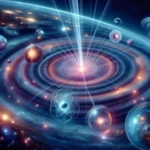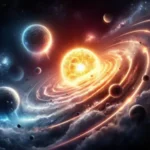The cosmos is a theater of breathtaking phenomena, and few events are as mesmerizing or monumental as a supernova—the cataclysmic explosion of a star that outshines entire galaxies for a brief period.
These stellar fireworks not only mark the end of a star’s life but also play a crucial role in the cosmic cycle, dispersing elements throughout the universe and giving birth to new celestial bodies. But how can we, from our vantage point on Earth, identify the signs of these spectacular explosions? In this blog post, we will delve into the fascinating world of supernovae, exploring the various indicators that precede and accompany their explosive demise. From their distinctive light curves to the telltale remnants left behind, we will guide you through the celestial clues that make spotting these awe-inspiring events both a challenge and a thrill for astronomers and stargazers alike. Prepare to embark on a journey through the universe, where the remnants of ancient stars illuminate our understanding of the cosmos!
1. Introduction to Supernovae
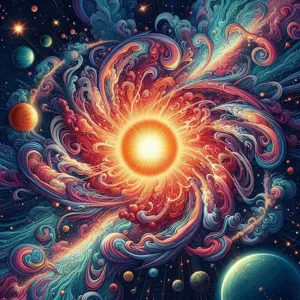
The cosmos is a theater of extraordinary events, and among the most breathtaking spectacles are supernovae—massive explosions that mark the death throes of stars. These cataclysmic phenomena are not just cosmic fireworks; they play a crucial role in the evolution of the universe. A supernova occurs when a star exhausts its nuclear fuel, leading to a dramatic collapse under its own gravity, followed by a violent explosion that can outshine entire galaxies for a brief period. This immense release of energy not only disperses the star’s material across the cosmos, enriching the interstellar medium with heavy elements essential for planet formation and life itself, but also serves as a crucial tool for astronomers to measure distances in the universe.
Supernovae come in two primary types: Type I and Type II, distinguished by their origins and mechanisms. Type I supernovae result from the thermonuclear explosion of a white dwarf in a binary system, while Type II supernovae arise from the core collapse of massive stars when they run out of nuclear fuel. Both types offer unique insights into stellar life cycles and the dynamics of galaxies.
As we delve deeper into the signs of a supernova, we will explore the various stages leading up to this spectacular explosion, the tell-tale signs that herald its arrival, and the lasting impact these events leave on the cosmic landscape. Whether you’re an aspiring astronomer or simply a curious stargazer, understanding supernovae enriches our appreciation for the universe’s complex and ever-evolving nature. Join us on this stellar journey as we uncover the mesmerizing signs of one of the universe’s most awe-inspiring phenomena.
2. What Causes a Supernova?
To understand what causes a supernova, we must first delve into the life cycle of a star. Stars are born from vast clouds of gas and dust in space, primarily composed of hydrogen and helium. Over millions of years, these elements collapse under their own gravity, forming a dense core that ignites nuclear fusion. This fusion process produces an immense amount of energy, balancing the inward pull of gravity and allowing the star to shine brightly for billions of years.
However, the fate of a star depends largely on its mass. For massive stars, typically those at least eight times heavier than our Sun, the end of their life cycle is a dramatic affair. As these stars exhaust their nuclear fuel, they undergo several stages of fusion, creating heavier elements in their cores—up to iron. At this point, the fusion process comes to a halt; iron cannot produce energy through fusion, leading to a catastrophic imbalance. Without the outward pressure generated by nuclear reactions, gravity takes over, causing the core to collapse rapidly.
This implosion triggers an explosive rebound effect, resulting in the outer layers of the star being propelled into space at incredible velocities. This explosion is what we recognize as a supernova. The release of energy during this event is mind-boggling; it can outshine entire galaxies for a brief period, scattering elements such as carbon, oxygen, and nitrogen across the cosmos, which are essential for the formation of new stars and planets.
In other scenarios, a supernova can occur when a white dwarf star—an end-stage star that has shed its outer layers—accumulates too much mass from a binary companion star. Once the dwarf reaches a critical mass, it ignites a runaway fusion reaction, leading to a thermonuclear explosion.
In summary, the causes of a supernova are rooted in the intricate balance between gravity and nuclear fusion within stars, disrupted when they reach the end of their life cycles. These spectacular explosions not only mark the death of a star but also play a crucial role in the cosmic ecosystem, seeding the universe with the building blocks necessary for new life.
3. Types of Supernovae: Type I vs. Type II
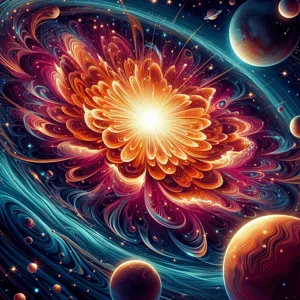
When it comes to understanding supernovae, it’s essential to recognize the two primary categories: Type I and Type II supernovae. Each type has distinct characteristics and occurs under different cosmic circumstances, making them both fascinating subjects of study in the field of astrophysics.
**Type I Supernovae** are typically the result of a white dwarf star in a binary system. As this white dwarf orbits its companion star, it siphons off material, gradually accumulating mass. Once it reaches a critical threshold—known as the Chandrasekhar limit—it can no longer support itself against gravitational collapse. This leads to a catastrophic explosion, ejecting the star’s outer layers at incredible speeds, often exceeding 10,000 kilometers per second. The result is a brilliant display of light that can outshine an entire galaxy for a short period, providing astronomers with valuable data to measure cosmic distances and understand the expansion of the universe.
On the other hand, **Type II Supernovae** originate from massive stars—those with at least eight times the mass of our Sun. These stars undergo a life cycle that culminates in the fusion of heavier elements in their cores, eventually leading to the formation of an iron core. When the core becomes too dense and cannot undergo further fusion, it collapses under its own gravity, resulting in a shock wave that blasts the outer layers of the star into space. Unlike their Type I counterparts, Type II supernovae are often accompanied by a distinct hydrogen signature in their spectra, enabling scientists to differentiate between the two types. The sheer energy released during these explosions is awe-inspiring, and they can leave behind fascinating remnants, such as neutron stars or black holes.
Understanding the differences between Type I and Type II supernovae not only enriches our knowledge of stellar evolution and death but also enhances our appreciation for the dynamic processes that shape the universe. Each explosion tells a story—of birth, destruction, and the intricate dance of matter and energy that continues to unfold in the cosmos.
4. The Life Cycle of a Star Leading to a Supernova
The life cycle of a star is a fascinating and complex journey that culminates in one of the universe’s most spectacular events: the supernova. Understanding this journey can help us appreciate the incredible forces at play in the cosmos. It all begins in a nebula, a vast cloud of gas and dust, where gravity pulls particles together to form protostars. As these protostars accumulate mass, their cores heat up, eventually igniting nuclear fusion—this marks the birth of a star.
Once a star achieves stability, it enters the main sequence phase, where it spends most of its life fusing hydrogen into helium. This process can last billions of years, depending on the star’s mass. Massive stars, in particular, burn through their hydrogen fuel at a much faster rate than their smaller counterparts, which leads them through a series of stages, drastically altering their composition and structure.
As a massive star exhausts its hydrogen, it begins to fuse heavier elements like helium, carbon, and oxygen in its core. This process creates an intricate layering effect, similar to an onion, where each shell fuses a different element. Eventually, the core becomes predominantly iron. Here lies a crucial turning point: once the core is primarily iron, fusion no longer releases energy; instead, it requires energy, leading to an imbalance as the outward pressure from fusion diminishes.
When the core collapses under its own gravity, the outer layers of the star are violently expelled in a cataclysmic explosion—a supernova. This explosion is not only a breathtaking sight, often outshining entire galaxies, but it also plays a vital role in the universe. It scatters heavy elements throughout space, contributing to the formation of new stars, planets, and even the building blocks for life as we know it. Understanding the life cycle of a star provides a deeper appreciation for the remarkable processes that shape the universe and the stunning phenomena we observe in the night sky.
5. Key Characteristics of a Supernova Explosion
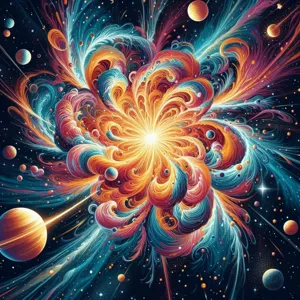
Supernova explosions are among the most awe-inspiring and cataclysmic events in the universe, marking the dramatic end of a star’s life cycle. To truly appreciate these cosmic spectacles, it’s essential to understand their key characteristics, which not only define them but also serve as indicators for astronomers attempting to observe and classify these powerful phenomena.
One of the most striking features of a supernova is its luminosity. A supernova can outshine entire galaxies, radiating as much energy in a few weeks as the Sun will emit over its entire lifetime. This intense brightness makes them visible across vast cosmic distances, allowing astronomers to study them in detail. The light from a supernova can take millions of years to reach Earth, providing a glimpse into the universe’s past and the life cycles of distant stars.
Another critical aspect is the distinct light curves that supernovae exhibit. These curves, which track the brightness of a star over time, typically show a rapid rise to peak brightness, followed by a slow decline. The specific shape and duration of this light curve can vary depending on the type of supernova—Type Ia, for instance, has a characteristic sharp peak, while Type II may display a more gradual decline.
Chemical composition also plays a significant role in identifying supernovae. During the explosion, nucleosynthesis occurs, creating heavier elements from lighter ones. The spectrum of the light emitted reveals these elements, such as iron and nickel, which can be detected by astronomers using spectroscopy. This analysis not only helps classify the type of supernova but also offers insights into the chemical evolution of the universe, as these explosions are responsible for dispersing elements into the interstellar medium.
Finally, the remnant of a supernova is another key characteristic. What remains after the explosion can vary significantly—some may leave behind neutron stars or black holes, while others create expansive nebulae, often referred to as supernova remnants. These remnants can be observed long after the initial explosion and provide critical clues about the event’s energy and mass.
In summary, the key characteristics of a supernova explosion—its immense luminosity, unique light curves, chemical signatures, and resultant remnants—are essential for identifying and studying these extraordinary cosmic events. Understanding these features not only enriches our knowledge of stellar evolution but also enhances our appreciation for the dynamic and ever-changing universe we inhabit.
6. Brightness and Light Curves: Understanding the Luminosity
When it comes to spotting a supernova, one of the most critical indicators is its brightness and the accompanying light curves. A supernova is not just a fleeting flash in the cosmic landscape; it is an extraordinary event that can outshine entire galaxies for a brief period, making it a beacon of light in the night sky. Understanding the intricacies of luminosity and how it changes over time is essential for both amateur astronomers and seasoned astrophysicists alike.
As a supernova erupts, it releases an immense amount of energy, causing its brightness to surge to incredible levels. This initial explosion can result in a luminosity that is thousands of times greater than that of the Sun. However, the brightness of a supernova does not remain constant. By observing its light curve—the graph that plots brightness against time—scientists can glean valuable insights into the nature of the explosion and the star that preceded it.
The light curve typically exhibits a rapid rise in brightness, peaking within days to weeks after the explosion, followed by a gradual decline. This decline can reveal crucial information about the supernova’s type. For instance, Type Ia supernovae, which occur in binary systems, often show a characteristic light curve shape that can help astronomers measure cosmic distances. In contrast, core-collapse supernovae, arising from massive stars, might display a more varied light curve, influenced by the ejected material and the energy released during the explosion.
By studying these light curves, astronomers can also determine the amount of radioactive isotopes produced in the explosion, which contributes to the energy powering the fade of the supernova over time. This understanding of luminosity not only allows researchers to classify supernovae more accurately but also provides insight into the life cycles of stars and the chemical evolution of galaxies.
In conclusion, by paying close attention to the brightness and light curves of supernovae, we unlock the secrets of these magnificent cosmic events. Each flicker of light tells a story of stellar death and rebirth, illuminating the ever-evolving tapestry of our universe.
7. Spectral Signatures: What to Look For
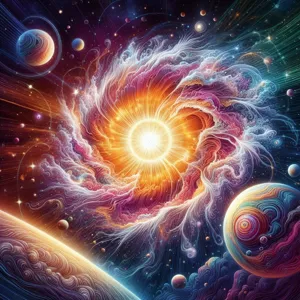
When it comes to identifying the signs of a supernova, one of the most fascinating tools in our astronomical toolkit is the spectral signature. Spectroscopy allows scientists to analyze the light emitted or absorbed by celestial objects, revealing invaluable information about their composition, temperature, and motion. For supernovae, these signatures provide critical clues about the explosive processes occurring during their spectacular demise.
When observing a supernova, astronomers look for specific spectral lines that indicate the presence of various elements. For instance, the appearance of hydrogen lines suggests that the explosion may have originated from a massive star, while the presence of heavier elements like iron or silicon hints at a Type Ia supernova, which arises from the thermonuclear explosion of a white dwarf star. Each element emits light at distinct wavelengths, creating a unique fingerprint that can be detected by powerful telescopes.
Additionally, a shift in these spectral lines can reveal information about the supernova’s velocity. When elements are moving away from us, their light stretches into longer wavelengths, a phenomenon known as redshift. Conversely, if they are moving toward us, we observe a blueshift. This Doppler effect helps astronomers determine how fast the supernova is expanding and can even provide insights into the dynamics of the explosion itself.
By carefully analyzing these spectral signatures, scientists can piece together the story of a supernova’s life and death, providing a deeper understanding of the processes that govern our universe. So, the next time you gaze up at the night sky, remember that each twinkling star could be a distant supernova, its spectral light whispering secrets of stellar evolution and cosmic drama.
8. Detecting Supernovae: The Role of Telescopes
When it comes to detecting supernovae, telescopes are our most powerful allies in the quest to uncover these cosmic spectacles. These fascinating astronomical events occur when a star exhausts its nuclear fuel and undergoes a cataclysmic explosion, outshining entire galaxies for a brief period. To capture such fleeting brilliance, astronomers rely on a variety of telescopes, each designed to observe the universe in different wavelengths of light.
Optical telescopes, equipped with large mirrors and advanced imaging technology, are adept at picking up the visible light emitted during a supernova’s explosion. These instruments allow astronomers to analyze the light curves and spectra, revealing critical information about the supernova’s type and the processes at play during the explosion. Modern observatories, such as the iconic Hubble Space Telescope, have revolutionized our understanding, providing stunning images of supernova remnants and enabling detailed studies of their composition and evolution.
In addition to optical telescopes, radio telescopes play a crucial role in detecting the aftermath of supernovae. These instruments can sense the radio waves emitted by shock waves as they interact with the surrounding interstellar medium. This unique perspective helps astronomers track the expansion of supernova remnants over time, offering insights into the dynamics of stellar explosions.
Moreover, with advancements in technology, space-based telescopes like the upcoming James Webb Space Telescope will significantly enhance our ability to detect and study supernovae in distant galaxies. By observing in infrared wavelengths, these instruments will penetrate cosmic dust clouds that often obscure our view of these spectacular events.
By harnessing the capabilities of various telescopes, astronomers are not only able to detect supernovae but also piece together the intricate puzzle of their life cycles. Each observation adds to our knowledge of stellar evolution, the chemical enrichment of the universe, and the fundamental processes governing cosmic phenomena. So the next time you gaze up at the night sky, remember that behind those twinkling stars, telescopes around the world are working tirelessly to uncover the explosive secrets of the universe.
9. Observing in Different Wavelengths: Optical, Radio, and Infrared
When it comes to unveiling the mysteries of supernovae, observing in different wavelengths is akin to wearing a multi-faceted pair of glasses that reveals various aspects of these cosmic titans. Each wavelength—optical, radio, and infrared—offers a unique perspective, illuminating different characteristics of the explosion and the remnants left behind.
**Optical observations** are perhaps the most familiar approach, allowing us to see the dazzling light emitted during a supernova’s explosion. Through telescopes that capture visible light, astronomers can witness the brilliant flash that marks the death of a star. This initial burst is often accompanied by a spectrum of colors, which can reveal crucial information about the elements produced in the explosion. For instance, the presence of hydrogen, helium, and heavier elements can be identified, providing insight into the star’s composition before its cataclysmic end.
**Radio observations**, on the other hand, penetrate the dense clouds of dust and gas that often obscure our optical views. Using radio telescopes, astronomers can detect the high-energy particles emitted by a supernova, often resulting from the fast-moving shockwave created by the explosion. This radio emission can persist long after the initial explosion, allowing scientists to monitor the supernova remnants over time and study the interaction of the blast with surrounding material.
Lastly, **infrared observations** offer a glimpse into the cooler aspects of a supernova’s aftermath. While the optical light may fade, infrared radiation can reveal the heat emitted by the debris as it cools down. This is particularly useful for identifying the dust created during the explosion, which plays a crucial role in the formation of new stars and planets. By studying these infrared emissions, astronomers can piece together the life cycle of stars and the processes that follow their spectacular deaths.
By combining data across these wavelengths, scientists can create a comprehensive picture of supernovae, unraveling the complexities of these cosmic explosions and enhancing our understanding of the universe’s evolution. So, the next time you gaze into the night sky, remember that the light you see is just one part of a grand tapestry woven from many threads, each revealing a different story of stellar life and death.
10. Historical Supernovae: Examples and Their Impact
Throughout the annals of astronomical history, several supernovae have left an indelible mark on both science and human culture. These cosmic fireworks not only illuminate the night sky but also serve as pivotal events in our understanding of the universe. One of the most famous historical supernovae is SN 1054, which was observed by Chinese astronomers over a millennium ago. This explosion gave birth to what we now recognize as the Crab Nebula, a stunning remnant that continues to be a focal point for astrophysical research. The observations made by ancient cultures have provided invaluable data, allowing scientists to piece together the life cycles of stars and the mechanics of stellar explosions.
Another significant example is SN 1572, also known as Tycho’s Supernova, which was observed by the Danish astronomer Tycho Brahe. This event challenged the long-held belief that the heavens were immutable and unchanging, as it visibly altered the night sky. Tycho’s meticulous observations laid foundational groundwork for future astronomers, including Johannes Kepler, who later studied the remnants and their implications for star formation and evolution.
Moving into the modern era, SN 1987A marked a watershed moment in astrophysics. Detected in the Large Magellanic Cloud, this supernova was the closest observed event of its kind in over 400 years, providing unprecedented opportunities for study. Astronomers were able to observe the explosion in real-time, leading to significant advances in our understanding of neutrinos and their role in stellar death. The insights gained from SN 1987A have fueled ongoing research into the life cycles of massive stars and the mysterious nature of dark energy and dark matter.
The impact of these historical supernovae extends beyond the realm of science; they have influenced art, literature, and our very perception of the cosmos. By exploring these spectacular explosions, we not only uncover the secrets of the universe but also reflect on our place within it, reminding us of the ever-changing, dynamic nature of the cosmos. Each supernova serves as a poignant reminder of the life cycle of stars, the birth of new elements, and the continual evolution of the universe itself.
11. Citizen Science: How You Can Help Spot Supernovae
Citizen science is revolutionizing our understanding of the cosmos, and you can play a pivotal role in the quest to spot supernovae. With advancements in technology and the democratization of data, amateur astronomers and science enthusiasts are now empowered to contribute to real scientific research. platforms like Zooniverse and Galaxy Zoo invite volunteers to analyze vast datasets from telescopes around the globe, helping scientists identify potential supernova candidates.
One of the most exciting ways you can get involved is through projects that utilize images captured by large telescopes. These images, often taken over weeks or months, can show subtle changes in brightness that indicate a star is nearing its explosive end. By comparing images taken at different times, you can help identify those fleeting moments when a star’s light suddenly brightens, signaling a supernova event. Your keen eyes can make a significant difference, as these explosions can be faint and easily overlooked by automated systems.
Additionally, participating in these projects allows you to connect with a community of like-minded individuals who share your passion for the universe. You’ll have access to forums and discussions where you can share your findings, learn from experienced astronomers, and even engage with scientists about the latest discoveries.
So, whether you’re a seasoned stargazer with your own telescope or a curious mind with an interest in the night sky, there’s a place for you in the citizen science movement. Together, you and countless others can help uncover the mysteries of supernovae, contributing to humanity’s understanding of the universe while experiencing the thrill of discovery firsthand. Join the movement and become part of the cosmic quest to spot these spectacular explosions!
12. The Importance of Studying Supernovae in Cosmology
Studying supernovae is pivotal in the field of cosmology, as these spectacular explosions serve as cosmic beacons that illuminate our understanding of the universe. When a massive star exhausts its nuclear fuel and undergoes a catastrophic collapse, it releases an immense amount of energy, outshining entire galaxies for a brief period. This brilliance not only captivates astronomers but also provides invaluable data about the fundamental nature of the cosmos.
One of the key reasons supernovae are crucial in cosmology is their role as standard candles. Type Ia supernovae, in particular, exhibit a consistent peak brightness, allowing scientists to measure cosmic distances with remarkable accuracy. By analyzing the light from these events, researchers can map the expansion of the universe and gain insights into its rate of growth. This has profound implications for our understanding of dark energy—a mysterious force that is driving the accelerated expansion of the universe.
Furthermore, supernovae contribute to the cosmic chemical enrichment of the universe. During the explosion, they scatter heavy elements, such as carbon, oxygen, and iron, into the interstellar medium. These elements are the building blocks of planets and life as we know it. By studying the remnants of supernovae, astronomers can trace the origins of these elements and understand the processes that lead to the formation of new stars and planetary systems.
In addition, supernovae serve as natural laboratories for testing theories of stellar evolution and the fundamental laws of physics. The extreme conditions during these explosions provide a unique opportunity to observe phenomena such as neutron star formation and the behavior of matter under intense gravitational forces. This research not only enhances our comprehension of supernova mechanics but also informs broader theories about the life cycles of stars and the fate of the universe.
In essence, the study of supernovae is not merely an exploration of celestial fireworks; it is a vital pursuit that enriches our understanding of the universe’s past, present, and future. By unraveling the mysteries of these cosmic events, we glean insights into the very fabric of reality itself, making them indispensable to the field of cosmology.
13. Myths and Misconceptions About Supernovae
When it comes to supernovae, a plethora of myths and misconceptions abound, often blurring the line between fact and fiction. One of the most prevalent myths is that all supernovae result in a black hole. While it is true that some massive stars collapse into black holes after a supernova, others may leave behind neutron stars or simply disperse into space as remnants of their once-glorious existence.
Another common misunderstanding is the belief that supernovae are rare events in the universe. In reality, they occur relatively frequently—about once every 50 years in a galaxy the size of the Milky Way. However, due to the vastness of space and our limited observational capabilities, many go unnoticed. Furthermore, some may think that supernovae are just a single, isolated event; however, they are part of a complex life cycle of stellar evolution, intricately tied to the formation of elements and the evolution of galaxies.
People often confuse supernovae with meteors or shooting stars, but these phenomena are vastly different. Meteors are the result of small space debris burning up in Earth’s atmosphere, while supernovae are cataclysmic explosions marking the end of a star’s life.
Lastly, there’s the notion that observing a supernova is a straightforward process. In truth, the light from a supernova can take millions of years to reach Earth, meaning that what we observe today may be a glimpse into the distant past. This temporal aspect adds another layer of intrigue, showcasing how our understanding of the universe is a continual journey of discovery, often colored by the myths we create along the way. By debunking these misconceptions, we can better appreciate the awe-inspiring phenomena that supernovae truly are, enriching our knowledge of the cosmos and our place within it.
14. Future of Supernova Research: What’s on the Horizon?
As we gaze into the vast expanse of the universe, the study of supernovae continues to evolve, unlocking new mysteries and reshaping our understanding of cosmic events. The future of supernova research is an exciting frontier, marked by advancements in technology and collaborative efforts across the globe. Various upcoming projects and initiatives promise to enhance our ability to detect and analyze these spectacular explosions in unprecedented detail.
One of the most anticipated developments is the launch of next-generation space telescopes, such as the James Webb Space Telescope (JWST) and the Wide Field Infrared Survey Telescope (WFIRST). These instruments will allow astronomers to observe supernovae in different wavelengths, providing insights into their progenitors, explosion mechanisms, and the impact they have on their surrounding environments. With their enhanced sensitivity and resolution, researchers will be able to track the life cycles of stars leading up to their explosive deaths more accurately than ever before.
Moreover, the advent of gravitational wave astronomy opens a new chapter in supernova research. The detection of gravitational waves, ripples in spacetime caused by massive cosmic events, could offer a unique perspective on the dynamics of supernova explosions and their remnants. By correlating gravitational wave signals with electromagnetic observations, scientists can piece together a more comprehensive picture of these cosmic phenomena.
Collaboration is also set to play a pivotal role in the future of supernova research. The establishment of international networks of observatories will facilitate the rapid sharing of data, enabling astronomers to respond quickly to supernova events and analyze them collectively. This collaborative approach not only enhances our observational capabilities but also fosters a global community of researchers dedicated to unraveling the secrets of the universe.
As we stand on the brink of these advancements, the next few years promise to be a transformative period for our understanding of supernovae. With new tools, technologies, and collaborative efforts at our disposal, we are poised to explore the spectacular explosions that shape galaxies, forge elements, and illuminate the cosmos in ways we have yet to imagine. The journey into the heart of these stellar cataclysms is just beginning, and the discoveries that await us are sure to be nothing short of extraordinary.
15. Conclusion: The Beauty and Significance of Cosmic Explosions
As we draw our exploration of supernovae to a close, it becomes clear that these cosmic explosions are not merely spectacular displays of energy and light; they are profound events that hold immense significance in the grand tapestry of the universe. The beauty of a supernova lies not only in its visual splendor, which can briefly outshine entire galaxies, but also in its role as a catalyst for creation. Each explosion serves as a cosmic forge, scattering heavy elements throughout space, enriching the interstellar medium, and providing the building blocks for new stars, planets, and even life itself.
The transient nature of supernovae reminds us of the cyclical processes that govern our universe. These cataclysmic events mark the end of a star’s life cycle, yet they herald new beginnings, illustrating the delicate balance between destruction and creation. They challenge our understanding of stellar evolution and contribute to the cosmic narrative that spans billions of years.
Moreover, the study of supernovae has profound implications for our understanding of fundamental physics and cosmology. They have been instrumental in the discovery of dark energy and the expansion of the universe, reshaping our comprehension of the cosmos.
In witnessing a supernova, whether through the lens of a powerful telescope or through artistic interpretations, we are invited to ponder our place in the universe. These magnificent explosions are a testament to the dynamic and ever-changing nature of the cosmos, a reminder that even amidst destruction, beauty and wonder abound. As we continue to probe the mysteries of the universe, let us carry with us the awe inspired by these stellar fireworks, forever illuminating the night sky.
As we conclude our exploration of the wondrous signs of a supernova, we hope you’re inspired to look up at the night sky with a renewed sense of wonder and curiosity. These cosmic explosions not only mark the death of massive stars but also serve as a reminder of the dynamic and ever-changing universe we inhabit. By familiarizing yourself with the signs we’ve discussed, from the sudden brightness to the unique spectral signatures, you can become an amateur astronomer, ready to witness these spectacular events in your own backyard—or through the lens of a telescope. So, the next time you gaze at the stars, remember that among the twinkling lights, there could be a supernova in its grand finale, lighting up the cosmos. Keep exploring, keep questioning, and let the majesty of the universe inspire you!


